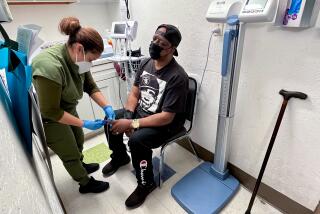Fetal monitors disappoint
- Share via
Use of fetal oxygen monitors during labor to determine whether a fetus is in distress does not reduce the rate of caesarean deliveries or improve the health of infants, researchers report today.
The OxiFirst instruments were introduced six years ago in the hope that, by supplementing information obtained with fetal heart monitors, they would make vaginal deliveries safer and reduce the need for C-sections.
But a study of nearly 5,000 births showed no benefit, according to the report in the New England Journal of Medicine. The findings were so conclusive that the study was terminated early.
“What we were really hoping was that knowledge of a baby’s oxygen saturation would be helpful,” said Dr. Catherine Spong of the National Institute of Child Health and Human Development, one of the study’s authors. “It was disappointing that that wasn’t the case.”
The institute sponsored the study, which was carried out at 14 university hospitals around the country under the auspices of the National Institutes of Health.
After the release of the findings, OxiFirst’s manufacturer, Tyco International Ltd.’s Nellcor unit in Pleasanton, Calif., said it would no longer distribute the sensors needed for the monitors, effectively withdrawing the instrument from the market.
The new results were “the nail in the coffin” for the device, said Dr. Thomas J. Garite of UC Irvine, who was among the first obstetricians to study it.
OxiFirst was conditionally approved by the Food and Drug Administration in 2000, but the $10,000 monitor was not widely adopted as physicians and hospitals waited for results from the current study.
The monitor works in much the same way as devices that are placed on a fingertip to measure blood oxygen levels through the skin. The OxiFirst sensor is manually inserted through the cervix and placed against the fetus’ cheek or forehead after the mother’s water has broken.
The idea was that by keeping close tabs on the fetus’ oxygen level, doctors would know whether it was safe to continue with a vaginal delivery despite other signs of distress.
A team led by Dr. Steven Bloom of the University of Texas Southwestern Medical Center enrolled 5,341 first-time mothers. The sensor was inserted into all of the mothers, but the readings from the sensor were made available to only half of the attending physicians.
In 507 cases, the device was removed because of technical problems or at the request of the mother or doctor.
The information from the monitor apparently did not improve fetal care, the researchers found. Overall, just over a quarter of the mothers in each group had caesarean deliveries, and the health of the infants was the same in both groups.
Although researchers had originally intended to enroll 10,000 women, they stopped the study early. “The results were conclusive at that point,” Bloom said, “that knowledge of fetal oxygen saturation did not improve caesarean rates or fetal condition.”
Garite, however, argued that the study should have focused on cases involving abnormal fetal heart rates. Because the team included all pregnancies, “I would not have expected them to show benefit,” he said. “It is very possible that they are throwing out a good instrument.”
Dr. Khalil Tabsh of the UCLA School of Medicine, which had stopped using the devices based on small studies, conceded that they might help the occasional patient. “But why should we spend the money to use it on everybody when it is not cost-effective?” he asked.
*






